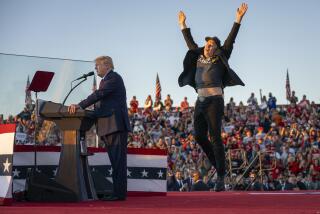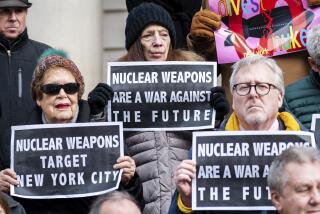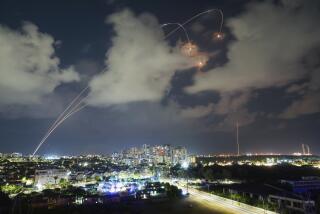Does America Need a Star Wars Missile Defense System? : No: We’re infinitely more vulnerable to chemical or terrorist attacks.
- Share via
Anyone who does a modest amount of channel-surfing these days can’t help but notice that there are more “Star Wars” reruns on C-SPAN than on HBO. This week, congressional Republicans will try for the third time in less than two years to enact legislation that mandates swift deployment of a national ballistic missile defense system. Their latest initiative, called the Defend America Act, is a thoroughly political statement that says nothing new or thoughtful about how to deal with current security threats. Once again, “Star Wars” deserves a thumbs down.
In the 1980s, millions of people feared a large-scale nuclear war between the United States and the Soviet Union. A “Star Wars”-type defense had a certain appeal in that context, although it faded when the technical complexity and cost became clear. Today, Americans are much more worried about attacks by rogue nations, terrorist groups, militia members wielding pipe bombs or lone Unabombers. Violence is becoming more diffuse, less predictable, closer to home.
In this context, it’s not clear why GOP leaders continue to pitch ballistic missile defense. Advocates have yet to explain how national missile defenses will block bombings of federal office buildings or poison gas attacks on subways. Security personnel in Atlanta are training for this summer’s Olympics by responding to simulated terrorist releases of biological weapons. Even more chilling is the likelihood of terrorists acquiring enough highly enriched uranium or plutonium for a crude nuclear weapon. Paradoxically, Republicans are trying to dismantle the very agency that is leading U.S. efforts to improve safeguards for tons of weapon-usable materials in the former Soviet republics: the Energy Department.
Sens. Sam Nunn (D-Ga.) and Richard Lugar (R-lnd.) recently held a series of hearings on the threat posed by nuclear, chemical and biological weapons. Nunn and Lugar are considering increasing funds for security at Russian nuclear sites, training and equipping customs agents in transit countries to detect nuclear smuggling and creating emergency response teams to handle chemical and biological attacks in the U.S. These policies lack high-tech glamour, but they do much more than missile defenses to address the real possibility of terrorists using weapons of mass destruction on U.S. soil.
It is no more pleasant to contemplate such threats than it was a decade ago to calculate how many millions of people might die in a massive nuclear exchange. Concepts like “Star Wars” are attractive because they seem to offer an escape from these dilemmas. But there are no simple solutions to problems as complex as the proliferation of nuclear, chemical and biological weapons. To the extent that the Defend America Act claims to protect Americans against such threats, it would be better named the Defraud America Act. Or the Defund America Act, since deploying a national missile defense system would be extremely expensive. The Congressional Budget Office estimates that the cost just to build the system called for in the Defend America Act would be $31 billion to $60 billion. The cost to operate it would be even more. And if the U.S. fields national missile defenses, Russia could refuse to ratify the START II nuclear reduction treaty, forcing the U.S. to retain 6,000 strategic nuclear warheads allowed under the START I treaty. The Defense Department estimates that would cost an extra $10 billion.
National security debates were simpler in the 1980s. There was one clear enemy, threats were more predictable and money seemed to be no object where military preparedness was concerned. But the 1980s are over. If “Star Wars” fans miss those times, that’s why we have video stores.
More to Read
The complete guide to home viewing
Get Screen Gab for everything about the TV shows and streaming movies everyone’s talking about.
You may occasionally receive promotional content from the Los Angeles Times.






